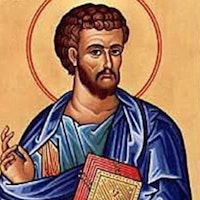“Which of these three, do you think, proved neighbor to the man who fell among the robbers?” He said, “The one [a Samaritan] who showed mercy on him.” And Jesus said to him, “Go, and do likewise.”
Saint Luke

The Good Samaritan
Topic: Love, Compassion, & Kindness
A lawyer stood up to put Jesus to the test, saying, “Teacher, what shall I do to inherit eternal life?” He said to him, “What is written in the Law? How do you read?” And he answered, “You shall love the Lord your God with all your heart, and with all your soul, and with all your strength, and with all your mind; and you shall love your neighbor as yourself.” And he said to him, “You have answered right; do this, and you will live.”
But he, desiring to justify himself, said to Jesus, “And who is my neighbor?” Jesus replied, “A man was going down from Jerusalem to Jericho, and he fell among robbers, who stripped him and beat him, and departed, leaving him half dead.
Now by chance, a priest was going down that road; and when he saw him he passed by on the other side. So likewise a Levite, when he came to the place and saw him, passed by on the other side. But a Samaritan, as he journeyed, came to where he was; and when he saw him, he had compassion, and went to him and bound up his wounds, pouring on oil and wine; then he set him on his own beast and brought him to an inn, and took care of him. And the next day he took out two denarii and gave them to the innkeeper, saying, ‘Take care of him; and whatever you spend, I will repay you when I come back.’ Which of these three, do you think, proved neighbor to the man who fell among the robbers?” He said, “The one who showed mercy on him.” And Jesus said to him, “Go, and do likewise.”
Saint Luke, also known as Luke the Evangelist, was born a Greek and a Gentile in Antioch, Syria. He was a physician and it is believed that he may have also been a slave, as it was not uncommon in his day for slaves to be educated in medicine so the family would have a resident physician. He was the first Christian physician and was venerated by the Catholic Church as the patron saint of physicians and surgeons.
Luke joined Paul at Troas in the year 51, accompanying him from Macedonia to Philippi. It is very possible that Luke provided medical assistance to Paul when he had been beaten, stoned, or nearly drowned while evangelizing to the Western Roman Empire. Luke explains in the introduction to his gospel that his writings were inspired by close association with Paul and his companions.
In the stained glass window at St. John's Episcopal Church in Stamford, Connecticut, St. Luke is shown holding a book that represents his Gospel. In his other hand, he holds a plant, representing healing herbs. Luke remained with Paul to the end of his life, even during his imprisonment and sufferings, "Only Luke is with me" (2 Timothy 4:11).
Luke is the only Gentile to have written books in the Bible. He is the writer of the third Gospel and the Acts of the Apostles and his writings have been proven to be historically accurate.
In the third Gospel, Luke emphasizes Christ's compassion for sinners and for those who suffer. The gospel of Luke focuses on the poor and oppressed, encouraging tenderness and compassion for the less fortunate. The story of Lazarus and the Rich Man who ignored him is told in Luke's gospel, as is the parable of the Good Samaritan.
The Gospel of Luke stresses the importance of evangelizing to the Gentiles. In the Gospel of Luke, we hear Jesus praising the faith of Gentiles such as the widow of Zarephath and Naaman the Syrian (Lk.4:25-27), and we hear the story of the one grateful leper who is a Samaritan (Lk.17:11-19).
Unlike the Jewish writings, women have an important place in Luke's gospel. Luke writes about the women who accompanied Jesus, such as Mary Magdalene, Joanna, Susanna, and Martha and Mary, and "many other women who used their own resources to help Jesus and his disciples" (8:1). Luke also writes about the birth of Christ from Mary's point of view and she is especially important in Luke's gospel.
It is only in the gospel of Luke that the story of Mary's Annunciation, her visit to Elizabeth, the Magnificat, the Presentation and Jesus' remaining in Jerusalem are told. In Luke's gospel, we learn the words spoken by the angel to Mary at the Annunciation, "Hail Mary, full of grace" and Elizabeth's words to Mary, "Blessed are you and blessed is the fruit of your womb, Jesus."
Luke's Christian ministry can be followed in the book of Acts. Up until the sixteenth chapter the story of Acts is written in the third person, much like an historian recording facts. The voice of the narrator then changes to first person and scholars believe this is done at the time Luke first joined Paul at Troas in the year 51. The book of Acts switches back to third person and scholars believe that this reflects a period in time when Luke was not present during the events that are recorded.
Though some historians claim that St. Luke was martyred after the death of Saint Paul, others say he lived a long life, dying at the age of 84 after settling in Greece to write his gospel.
Parable of the Good Samaritan
Wilson, Andrew, editor. World Scripture - a Comparative Anthology of Sacred Texts. Paragon House, 1991, pp. 686-687 [Luke 10.25-37: Parable of the Good Samaritan].

Saint Luke
Theme: Compassion

About Luke 10.25-37: Jesus of Nazareth’s Parable of the Good Samaritan [Commentary]
In the Parable of the Good Samaritan, found in the Gospel of Luke, Jesus of Nazareth teaches a lesson on compassion that transcends cultural and religious boundaries. The context begins with a lawyer testing Jesus by asking how to inherit eternal life. Jesus directs him to the Law, which commands love for God and neighbor. When the lawyer asks, “And who is my neighbor?” Jesus responds with a story highlighting a Samaritan’s act of mercy toward a wounded man, contrasting it with the neglect shown by a priest and a Levite. The message is clear: compassion is the true measure of a neighbor.
The quotation, “Which of these three, do you think, proved neighbor to the man who fell among the robbers?” followed by, “The one who showed mercy on him,” and Jesus’ directive, “Go, and do likewise,” emphasizes compassion. Jesus challenges societal norms by portraying a Samaritan, traditionally viewed with disdain by Jews, as the hero who exemplifies true neighborly love. This parable critiques the self-righteousness and ritual purity concerns of religious leaders, showing that genuine compassion transcends legalistic boundaries and social prejudices.
In the broader context, Jesus underscores that eternal life is linked with love and mercy. The lawyer’s attempt to justify himself is met with a story that redefines the concept of a neighbor. Through the Samaritan’s actions, Jesus illustrates that compassion is an active, selfless response to the suffering of others, regardless of their identity or our preconceptions. This teaching encourages us to embody compassion in our daily lives, urging us to see every person as a neighbor deserving of mercy and care.
Alexander Ciurana about Martin Luther King, Jr.’s sermon on the parable of the Good Samaritan
On November 20, 1955—less than one month after becoming the pastor of the Dexter Avenue Baptist Church—Martin Luther King, Jr. preached on the parable of the Good Samaritan (Carson, 2007, pp. 239-240). The story is found in the gospel of Luke chapter 10.
The sermon’s title alone is striking, “The One-Sided Approach of the Good Samaritan” (Carson, 2007, p. 239).
Yet King was able to find “shortcomings of the parable in describing true neighborliness” (as cited in Carson, 2007, p. 239); and revolutionary because he expanded upon the Samaritan’s good by seeking the perfection of that good through deeper actions that uproot systems of evil, rather than a simple nursing of its victims.
How did the 26 years-old Martin find room for profound exposition of such a timeless and hallowed text? The most reasonable explanation I can provide for King’s insight is that his interpretation of scripture was inseparably linked to his personhood. When this is accomplished, age is no hindrance.
King’s basic critique in this sermon was that the Good Samaritan only addressed the temporal, one-time effect of what was in reality a Jericho road epidemic. What of all those who would come after this poor, beaten man? What about the social ills that contributed to the rampant robbery and corruption on this long stretch of road? The Jericho road symbolized the domination of others, the corruption of systems that allow domination, and the inexcusable travail that affected those who must travel its path. King’s interpretation was one that demanded not only personal responsibility but community effort as well. It was the complete opposite of the privatized, ethereal, and spiritualized refrain of one old hymn.
The cure for these social and moral ills (still with us today), it would seem, would be to identify with the beaten man. I do not mean to have mere pity for what he symbolizes, but to actually see oneself as vulnerable as he. Each one of us has trod the Jericho road.
—C. Carson, Editor. (2001). [The autobiography of Martin Luther King, Jr. New York: Grand Central Publishing]. And, (2007). [The papers of Martin Luther King, Jr. (University of California, Berkeley, CA].
Luke 10.25-37: Jesus of Nazareth’s Parable of the Good Samaritan
Luke 10.25-37: This parable is both a lesson on universal compassion and a warning against self-righteousness on the part of religious people. ‘My neighbor’ means the man half-dead on the road, whom the priest passed by on the other side because of the ritual prohibition against touching a dead body: this recalls the controversy over healing on the sabbath, see Matthew 12.9-14, p. 744. Such concern for ritual purity must yield before the demand for compassion. Then it is the Samaritan, long despised as a heretic by right-thinking Jews, who properly shows mercy and fulfills the Law, while the priest and Levite, who were respected religious leaders, did not.
—Andrew Wilson, World Scripture: A Comparative Anthology of Sacred Texts.
Resources
Related Quotes
Copyright © 2017 – 2024 LuminaryQuotes.com About Us